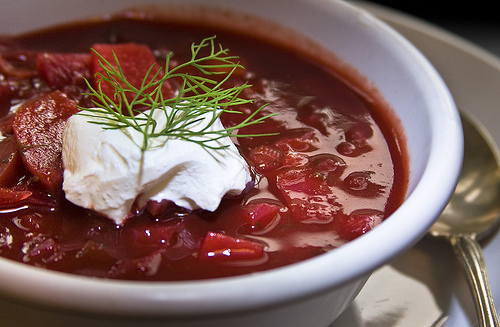By Alexei Summers (The Cascade) – Email
Print Edition: December 6, 2011
This week I’m feeling very passionate about borscht, and other foods of Russian origin.
While borscht was not invented by Vladimir Lenin, it was, and is a symbol of both socialism, and stoicism. Back in the days of Marshall Zhukov and Comrade Trotsky borscht was typically the first course of every lunchtime meal in the Union of Soviet Socialist Republics. It has always been considered a Soviet meal.
When most people think of Russia they think of two things – Borscht, and vodka. In the 20th century, both things became recognized staples of the evil empire – the Soviet Union. (That’s MR. Evil Empire, to you Ronald Reagan.) Borscht is Ukrainian in origin, which was a constituent republic of the USSR. It was originally made of scraps of whatever was left over from the fields. Families would keep a container specifically for borscht, and would throw whatever trimmings they could find in it. Since beetroot has aways been a very Russian/Slavic vegetable, it became the primary ingredient for the soup, and thus borscht was born. Because of this, I should probably mention that real borscht is always homemade. Ordering borscht at a restaurant just isn’t quite the same, and is a betrayal to the origins of the meal, which was born of the necessity of surviving the harsh Ukrainian winters. This is highly representative of the Russian mindset – waste not. Russians have always been a stoic demographic – hardened from the cold winters, and the years of political turmoil; they make do with whatever life hands to them. If that happens to be leftover beetroot trimmings, so be it – they’ll make a soup out of it, and they’ll find a way to make it damn tasty.
Every Slavic and Germanic culture has its own variation on the borscht recipe. None of them are wrong – just different. Odds are that if you’ve lived here in the Fraser Valley for any length of time, you’ve probably encountered the Mennonite community in some form or way. Not all borscht is of Russian origin – just as not all Mennonites are of Russian origin. The Mennonites, too, have a wonderful variant of borscht. It is nothing like the traditional Ukrainian version, but is instead made mainly from Cabbage rather than beetroot. Lepp’s Farm Market has a wonderful Cabbage Borscht available; it is fresh and made right in the store, based on an old Mennonite recipe passed down through generations.
The great thing about borscht is that it’s quite sexy and classy. It can be dressed up or dressed down. If you want to throw in a few extra ingredients, it’ll only better the soup. Or you can strip it down to its bare roots, and just make it completely vegetarian. This is the most common type of borscht, and is the traditional Ukrainian recipe.
Borscht can be the perfect accompaniment for a date night dinner if you’re cooking something at home for your sweetheart. It’s also a wonderful companion for those cold winter nights where you need something to keep you warm, and for when you are lonely. For centuries, Ukrainians and Russians have been enjoying this delicacy in the heart of the chilly winter – this comforting dish of warmth, and splendour. It is a symbol of stoicism, hardship and perseverance. It is distinctly Ukrainian, and distinctly sublime.
A wise Ukrainian man once said, ‘There is nothing more comforting in the heart of the winter than a steaming hot bowl of borscht.’
That man was me.


